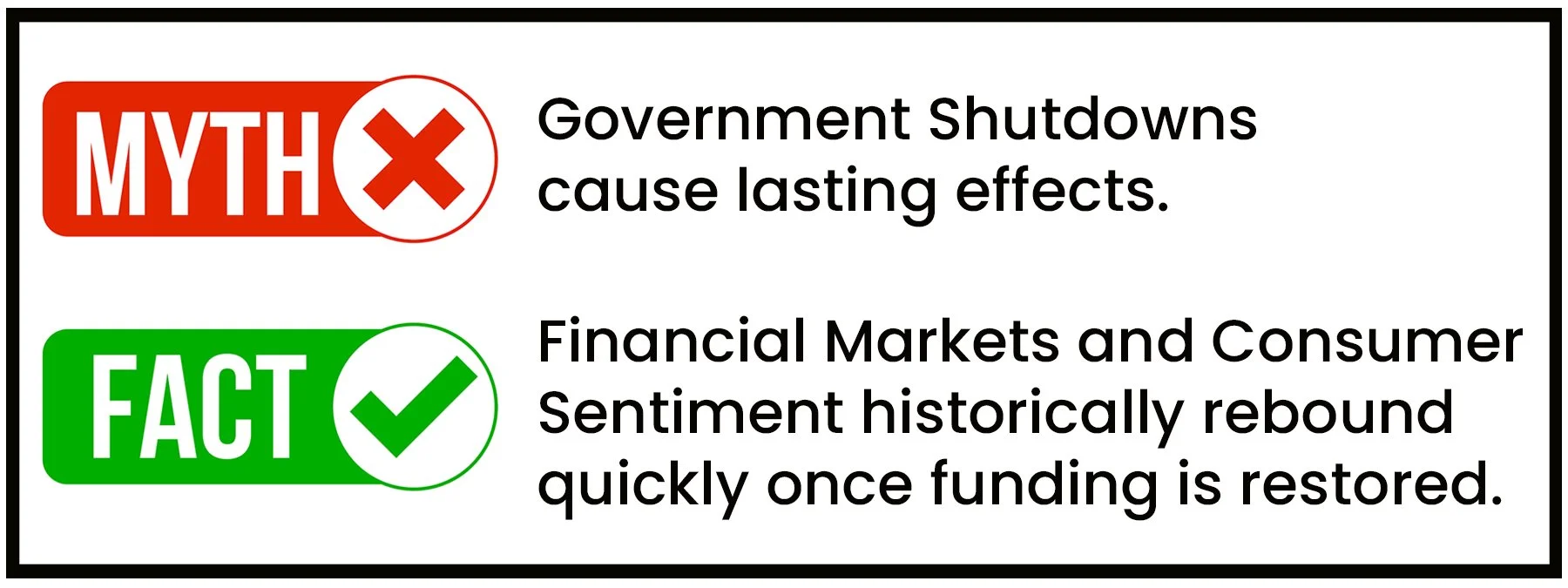Why Resilience Matters More Than Headlines
/Why Resilience Matters More Than Headlines:
What Investors Need to Know About a Government Shutdown
(10/1/2025) The federal government began to shut down overnight after Democrats and Republicans failed to come to an agreement to extend government funding ahead of the Oct. 1, 2025, deadline. When headlines warn of a potential government shutdown, it can stir up worry for both households and markets. For investors, the most important thing to remember is that while shutdowns are disruptive, they are not new—and history offers valuable perspective.
What Is a Government Shutdown?
A U.S. government shutdown occurs when Congress fails to pass the necessary spending bills to fund federal agencies and operations. This leads to a temporary suspension of many government functions, ranging from national parks and museums to certain regulatory agencies. Essential services—such as Social Security payments, the military, and air traffic control—continue to operate.
Market Impact: Short-Term Volatility vs. Long-Term Perspective
Markets dislike uncertainty, and shutdown headlines can spark short-term volatility. However, history shows that government shutdowns have generally had limited and temporary effects on the broader markets.
Equities: The S&P 500 has often experienced modest declines during shutdowns, but historically markets have rebounded once government funding is restored. For example, during the 2018–2019 shutdown (the longest in history), the S&P 500 rose more than 10% in the following month after a resolution was reached. (1,2,4)
Bonds & Interest Rates: Treasuries may benefit from “safe-haven” demand, though prolonged uncertainty could add pressure to credit markets. Notably, after the 2013 shutdown ended, Treasury yields stabilized quickly as confidence returned. (3)
Economic Data: Delays in the release of government statistics (such as jobs reports or inflation data) can create gaps in information, which may temporarily affect investor sentiment and policymaker decisions. Yet once data reporting resumes, markets tend to digest the backlog quickly and return to focusing on fundamentals. (2)
Practical Implications for Investors
Federal Workers and Contractors: Delayed paychecks can reduce consumer spending in the short run.
However, spending often rebounds quickly once back pay is issued, creating a temporary surge in consumer activity. After the 2018–2019 shutdown, retail sales rose sharply in February as federal employees caught up on deferred spending. (4)
Regulatory Approvals: Companies relying on government contracts or regulatory decisions (e.g., FDA approvals) may experience delays.
Once funding resumes, agencies typically work through backlogs quickly. After the 2013 shutdown, for example, the FDA and SEC cleared months of delayed reviews within weeks, with minimal long-term impact on businesses waiting for decisions. (7)
Confidence and Sentiment: Prolonged political standoffs can weigh on consumer and business confidence.
Yet confidence tends to rebound once a resolution is reached. Following the 2013 shutdown, the University of Michigan’s Consumer Sentiment Index climbed back nearly 10 points in the two months after funding was restored, and equity markets followed suit with a strong rally. (5,6)
Why Investors Should Stay the Course
It can be tempting to react quickly when political headlines dominate the news cycle. Yet, disciplined investors know that the markets are influenced far more by long-term fundamentals—corporate earnings, innovation, global growth—than by temporary Washington gridlock.
Past shutdowns have been measured in weeks, not years.
Market pullbacks during shutdowns have typically been modest and short-lived.
Long-term investors who maintained diversified portfolios have historically weathered these periods with minimal impact on their goals. (1,2)
Our Perspective
At Gilbert & Cook, we believe moments of uncertainty are when disciplined strategy matters most. Rather than letting political noise dictate investment decisions, we focus on aligning portfolios with long-term objectives—so that you can move forward with clarity and confidence.
Sources:
Northern Trust. (2025). Government Shutdown and Labor Market Risks. Retrieved from Northern Trust Insights
American Century Investments. (2023). How Do Government Shutdowns Affect Markets? Retrieved from American Century
State Street Global Advisors (SSGA). (2019). What the U.S. Government Shutdown Means for Markets and the Economy. Retrieved from SSGA
ABC News. (2019, January 28). What the government shutdown means for your investments. Retrieved from ABC News
University of Michigan – Surveys of Consumers. (2013). Policy uncertainty dims consumer confidence in September. Retrieved from ISR Michigan
PBS NewsHour. (2013, October 18). The shutdown is over, but consumer confidence hits 10-month low. Retrieved from PBS
Wikipedia. (n.d.). 2013 United States federal government shutdown. Retrieved from Wikipedia
Disclosure: The information provided in this article is for educational and informational purposes only and should not be construed as investment, legal, or tax advice. Past performance is not indicative of future results. Historical data on market performance following prior U.S. government shutdowns may not be representative of future outcomes, and investors should not assume that markets will respond in the same way to future events. All investments involve risk, including the potential loss of principal.
See important disclosure information at: gilbertcook.com/disclaimer




